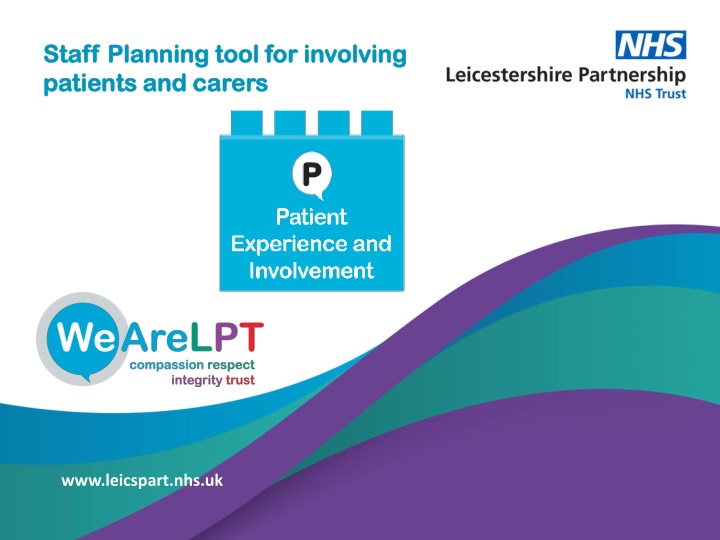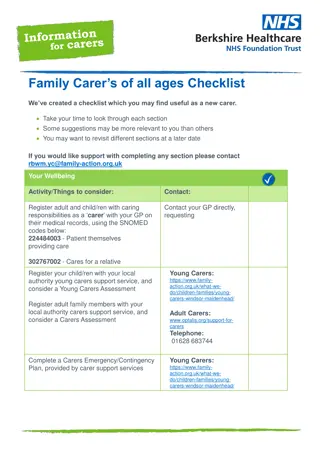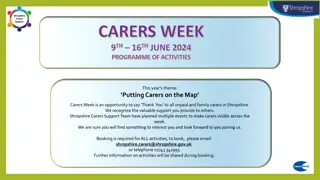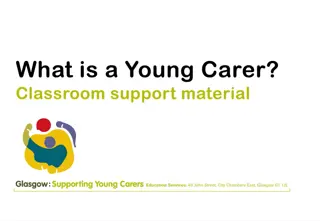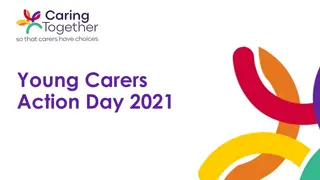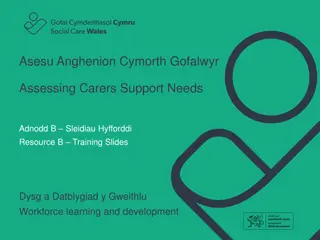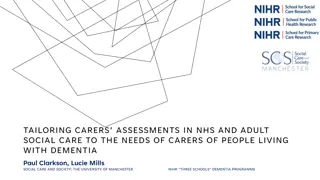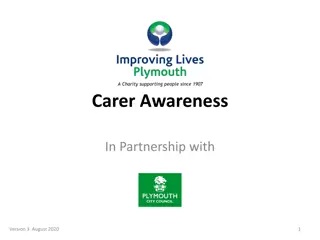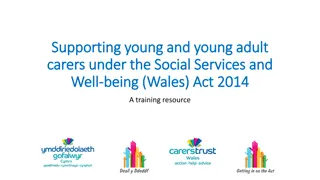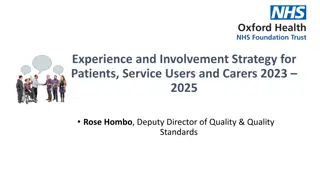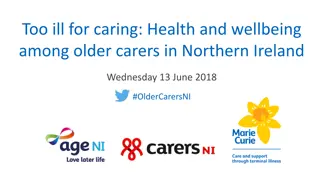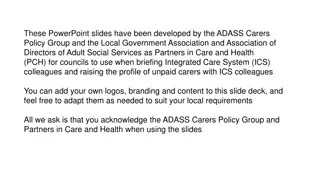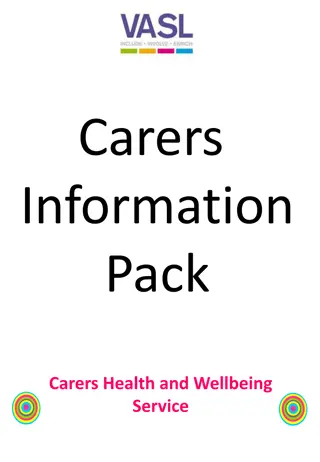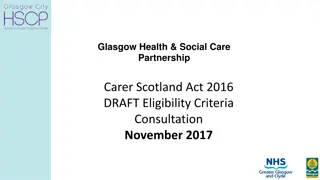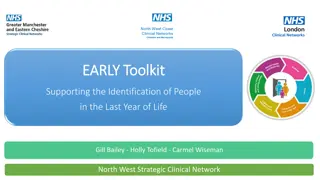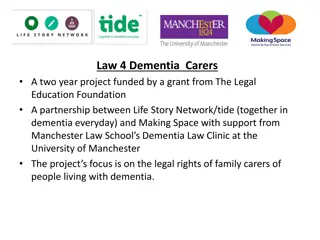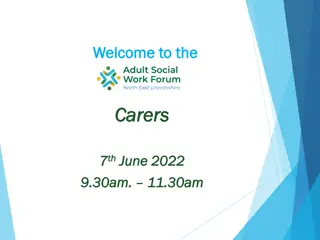Staff Planning Tool for Involving Patients and Carers
This planning tool supports services in involving patients and carers effectively. It guides users through different involvement tiers and examples, emphasizing the importance of patient engagement in service development. The tool aims to define the purpose of engagement activities and provide assistance in selecting the right level of involvement.
Download Presentation

Please find below an Image/Link to download the presentation.
The content on the website is provided AS IS for your information and personal use only. It may not be sold, licensed, or shared on other websites without obtaining consent from the author.If you encounter any issues during the download, it is possible that the publisher has removed the file from their server.
You are allowed to download the files provided on this website for personal or commercial use, subject to the condition that they are used lawfully. All files are the property of their respective owners.
The content on the website is provided AS IS for your information and personal use only. It may not be sold, licensed, or shared on other websites without obtaining consent from the author.
E N D
Presentation Transcript
Staff Planning tool for involving Staff Planning tool for involving patients and carers patients and carers www.leicspart.nhs.uk
Staff planning tool for involving patients and carers This planning tool has been developed to support you when you are considering involving patients and carers in your services. Please read through involvement framework to better understand what type of involvement activity you require, and the reward and recognition required. Then work through the sections providing as much information as possible, as this will help to define what type of engagement activities you may need to undertake and finance you may need to take into consideration. Please see the following link to the Trusts Reward and Reimbursement for Patients and Carers Policy. http://tinyurl.com/mr2m3ekm Once you have completed this document, please contact the Patient Experience and Involvement Team who will support you in terms of taking this work forward. Email LPT.Patient.Experience@nhs.net About the team Enabling: Supporting you and the involvement network members during your involvement project/activity. Advising: We are here to advise on what type of involvement will be most effective for your project/activity Guiding: We can help to guide you through the process of obtaining the right network member with the right level of experience for your specific project.
Involvement examples Tier 1 Tier 2 Tier 3 Tier 4 Tier 5 Patient/carer perspectives, patient story, sharing exp of using our services Getting involved in QI on a one off basis Patient/carer perspective on recruitment panels Member of level 3 committee, strategic roles e.g. People s Council member Paid role patient partner role Proving feedback on decisions about own care Attending a focus group Attending regular focus groups, QI, meetings working groups Co-delivery partner e.g. training, co-chair of coproduction/QI groups; Paid role peer support worker Reader panel feeding back on patient facing docs, draft surveys etc Invited to attend feedback event Part of review group Design Partner training Employment, salaried role For example: If you are looking for a focus group, you will want to consider tiers 2 and 3 on our involvement guide. If you want patients involved in interviews, then you want to consider tier 3. If you want patients to review a draft discharge letters, then you want to consider tier 1. If you are looking for a coproduction and codesign partner, then you want to consider tier 4. If you are looking for a Peer Support Worker, or are developing a substantive post then you want to consider tier 5.
Defining the purpose of engagement Prompting questions/ideas Description What will you do? The Trust will only engage where there is a clear reason to do so e.g: Providing intelligence to inform a review of a service To find out what the impact of changes to a service may be on patients To involve in developments of a new service Any work the Trust undertakes that will have an impact on the service the patient receives should be informed by engagement. What is the purpose of this engagement? List all service that the engagement activity relates to directly and indirectly. What services does this engagement cover? List all of those who will be affected by the activity you are engaging on Who will be most affected by the changes? EG users of the service, staff What Step up to Great priorities does this activity link to? Does it link into directorate transformation plans? EG DMH co- production groups How does this engagement activity link to the SUTG Do you have a budget for this involvement The Trust has a Reward & reimbursement policy for patients & carers: including travel
Activity Brief and Agreement Form Name of team/service: Responsible manager (buddy) name: Phone number: Email address: Name of activity, QI project, meeting etc : About the activity, role of the partner About the activity, role of the partner What is the purpose of this activity? Describe the role: How much time (outside of the activity) is required to fulfil the role e.g. for the reading of papers outside of meetings? How long with you require the role e.g. how long is the activity? Please describe the format of meetings i.e. how often to you meet, for how long, where? Is this time/frequency suitable? Who else will be there? Are the papers of a sensitive nature?
Additional information; Is an orientation of the directorate/ group/ service/ team required? Communication preferences - how will you communicate any tech issues, cancellation or non-attendance of meetings? How will the representative communicate non-attendance of meetings, to who and how? When and how will the representative be informed of meetings? How will the agenda and papers be sent and when? Is a pre meet required before meetings? Who will be point of contact in the absence of responsible manager? Is a de-brief required after activities/meetings? How will any changes be communicated? And those being involved kept updated of progress? How will you evaluate the involvement? Accessibility/Requirements Tech support Any additional support needs, eg Easy Read, IT
Please refer to the Trusts Reward and Recognition policy and define the level of reward and recognition that the role may attract (tick and describe all that apply): Out of pocket expenses, including any caring costs (reimbursement may take up to 30 days to process) Recognition Reward (financial, or non financial) Lunch (when activity is over 4 hours) Date activity brief created: I have read, understood and agreed to the terms contained in this written agreement. If any further information is required, or any concerns arise about what is set out above please contact the named responsible manager in this form in the first instance. Leicestershire Partnership NHS Trust would like to take this opportunity in advance to thank you for taking part in the Trusts Quality Improvement work. Signed (participant): . Date: Name (please print): . . Signed (responsible manager): . Date: Name (please print): . Once signed please retain one copy of this form with the service/Terms of Reference of the groups/committee or project (where appropriate). Provide the partner with a copy Send a copy of the completed form to the Patient Experience and Involvement Team at: LPT.Patient.Experience@nhs.net
